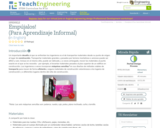
Los estudiantes diseñan y construyen un dispositivo de transporte a pequeña escala.
- Subject:
- Applied Science
- Engineering
- Material Type:
- Activity/Lab
- Provider:
- TeachEngineering
- Provider Set:
- Sprinkles
- Date Added:
- 01/01/2015

Los estudiantes diseñan y construyen un dispositivo de transporte a pequeña escala.
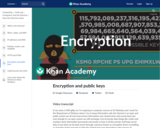
Mia Epner, who works on security for a US national intelligence agency, explains how cryptography allows for the secure transfer of data online. This video explains 256-bit encryption, public and private keys, SSL & TLS and HTTPS.
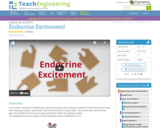
In this activity, students are divided into a group of hormones and a group of receptors. The hormones have to find their matching receptors, and the pair, once matched, perform a given action. This activity helps students learn about the specificity of hormone-receptor interactions within the endocrine system.
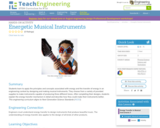
Students learn to apply the principles and concepts associated with energy and the transfer of energy in an engineering context by designing and making musical instruments. They choose from a variety of provided supplies to make instruments capable of producing three different tones. After completing their designs, students explain the energy transfer mechanism in detail and describe how they could make their instruments better.

Watch students as they conduct an energy audit on a home and gain hands-on experience for a career in the green energy industry, in this video adapted from ATETV.

Demos and activities in this lesson are intended to illustrate the basic concepts of energy science -- work, force, energy, power etc. and the relationships among them. The "lecture" portion of the lesson includes many demonstrations to keep students engaged, yet has high expectations for the students to perform energy related calculations and convert units as required. A homework assignment and quiz are used to reinforce and assess these basic engineering science concepts.
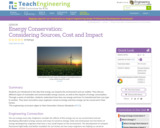
Students are introduced to the idea that energy use impacts the environment and our wallets. They discuss different types of renewable and nonrenewable energy sources, as well as the impacts of energy consumption. Through a series of activities, students understand how they use energy and how it is transformed from one type to another. They learn innovative ways engineers conserve energy and how energy can be conserved in their homes.
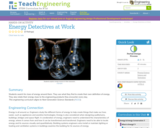
Students search for clues of energy around them. They use what they find to create their own definition of energy. They also relate their energy clues to the engineering products they encounter every day.
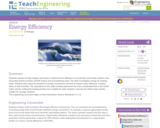
This Lesson provides two different activities that require students to measure energy outputs and inputs to determine the efficiency of conversions and simple systems. One of the activities includes Lego motors and accomplishing work. The other investigates energy for heating water. They learn about by products of energy conversions and how to improve upon efficiency. The teacher can choose to use either of these or both of these. The calculations in the water heating experiment are more complicated than in the Lego motor activity. Thus, the heating activity is suitable for older students, only the Lego motor activity suitable for younger students.
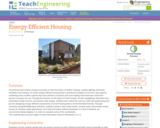
We all know that it takes energy to provide us with the basics of shelter: heating, cooling, lighting, electricity, sanitation and cooking. To create energy-efficient housing that is practical for people to use every day requires combining many smaller systems that each perform a function well, and making smart decisions about the sources of power we use. Through five lessons on the topics of heat transfer, circuits, daylighting, electricity from renewable energy sources, and passive solar design, students learn about the science, math and engineering that go into designing energy-efficient components of smart housing that is environmentally friendly. Through numerous design/build/analyze activities, students create a solar water heater, swamp cooler, thermostat, model houses for testing, model greenhouse, and wind and water turbine prototypes. It is best if students are concurrently taking Algebra 1 in order to complete some of the worksheets.
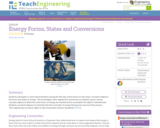
The students participate in many demonstrations during the first day of this lesson to learn basic concepts related to the forms and states of energy. This knowledge is then applied the second day as they assess various everyday objects to determine what forms of energy are transformed to accomplish the object's intended task. The students use block diagrams to illustrate the form and state of energy flowing into and out of the process.

Demonstrations explain the concepts of energy forms (sound, chemical, radiant [light], electrical, atomic [nuclear], mechanical, thermal [heat]) and states (potential, kinetic).
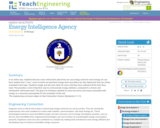
In an active way, students discover a few critical facts about how we use energy and how much energy we use. Each student has a "clue," some of which are pertinent energy facts and others are silly statements that are clearly unrelated to the topic. Students mingle and ask each other for clues until they have collected all the facts they need. This provides a more interactive way to communicate energy statistics, compared to a lecture and introduction with board work. The goal is to introduce students to some key terms and issues associated with energy as a necessary prerequisite for the remainder of the unit.
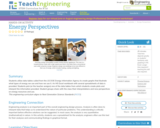
Students utilize data tables culled from the US DOE Energy Information Agency to create graphs that illustrate what types of energy we use and how we use it. An MS Excel workbook with several spreadsheets of data is provided. Students pick (or the teacher assigns) one of the data tables from which students create plots and interpret the information provided. Student groups share with the class their interpretations and new perspectives on energy resources and use.
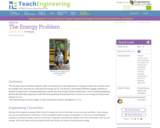
This six-day lesson provides students with an introduction to the importance of energy in their lives and the need to consider how and why we consume the energy we do. The lesson includes activities to engage students in general energy issues, including playing an award-winning Energy Choices board game, and an optional graphing activity that provides experience with MS Excel graphing and perspectives on how we use energy and how much energy we use.
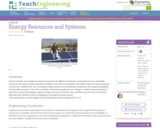
Several activities are included to teach and research the differences between renewable and non-renewable resources and various energy resources. The students work with a quantitative, but simple model of energy resources to show how rapidly a finite, non-renewable energy sources can be depleted, whereas renewable resources continue to be available. The students then complete a homework assignment or a longer, in-depth research project to learn about how various technologies that capture energy resources for human uses and their pros and cons. Fact sheets are included to help students get started on their investigation of their assigned energy source.
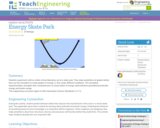
Students experiment with an online virtual laboratory set at a skate park. They make predictions of graphs before they use the simulation to create graphs of energy vs. time under different conditions. This simulation experimentation strengths their comprehension of conservation of energy solely between gravitational potential energy and kinetic energy

Fact sheets are provided for several different energy resources as a starting point for students to conduct literature research on the way these systems work and their various pros and cons. Students complete a worksheet for homework or take in-class time for research and presentation of their findings to the class. This approach requires students to learn for themselves and teach each other, rather than having the teacher lecture about the subject matter.

In Activity 5, as part of the Going Public step, students demonstrate their knowledge of how potential energy may be transferred into kinetic energy. Students design, build and test vehicle prototypes that transfer various types of potential energy into motion.
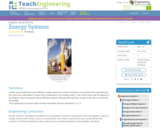
Posters are provided for several different energy conversion systems. Students are provided with cards that give the name and a description of each of the components in an energy system. They match these with the figures on the diagram. Since the groups look at different systems, they also describe their results to the class to share their knowledge.